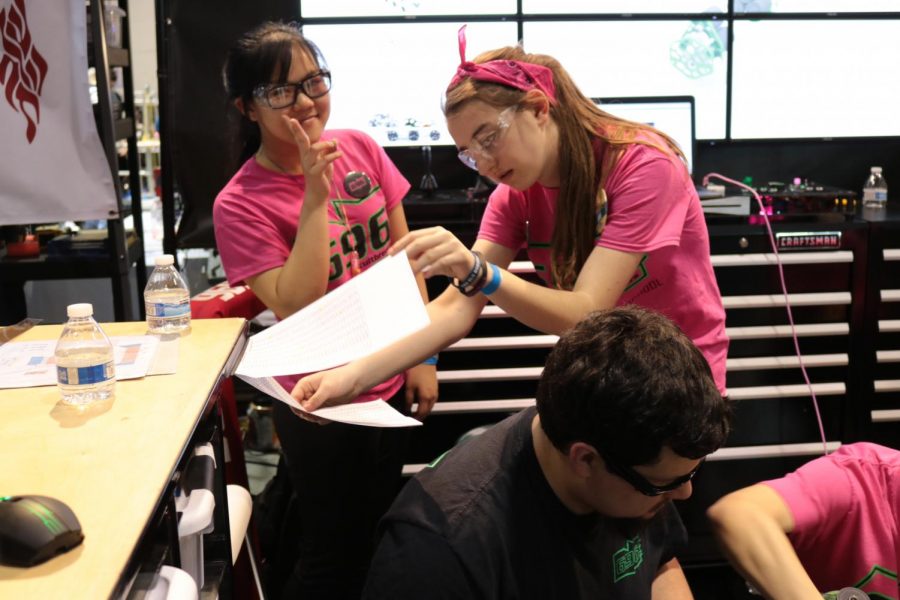The FIRST Power-Up Robotics Competition Quarterfinals leads to an epic finish
Team 696 closes the match, reaching the quarterfinals
On March 14-17, Team 696 participated in the FIRST Power-Up Robotics Competition. Initially, in 25th place, it looked like Team 696, Clark Magnet High School’s robotics team, had lost all hope finishing first place, but, luckily, the Fourth Seeded Alliance noticed their hardworking performance and allied themselves with Team 696 for the quarterfinals.
With a vow to win the competition, Team 696, Fourth Seeded Alliance and another allied team entered the quarterfinals with a strategy that would presumably counter the opponents, intercepting the opponents’ exchange zones, scales and switch. This tactic would dominate the first match until the opponents realized their failed plan and immediately strategized to counteract the Fourth Seeded Alliance team’s strategy that led to a loss in the second match.
With everything on the line, determining which team would advance to the semi-finals, both alliances intimidated one another with their robots’ gearing sounds and eyeing the different objectives. With the timer counting down, each team continued to firmly grip the robot controller, preparing for the match to begin.
However, the Fourth Seeded Alliance team’s strategy went awry with a mechanical robotic breakdown and a panicking pressure that led to all three robots targeting the scale, neglecting the other objectives. Because of this, Team 696 lost the quarterfinals and placed in 8th place with a score of 156-386 among 51 teams.
“The loss that we faced was more of a learning experience than anything,” said junior Ismail Hasan. “Afterwards, we evaluated what we did wrong, and what we as a team, needed to do to perform better.”
On March 14, 51 robotics team from the Los Angeles region proceeded to exercise their robots, checking for any mechanical errors and preparing for the preliminary round. In reality, this first day was a practice day, with many teams observing each other to potentially align with, basing their options on skills, teamwork and cooperation.
On March 15, the competition began with qualification matches that determined each teams’ rankings and would officiate which teams would move on to the official rounds, which consisted of each qualifying team having two other aligned teams to compete against the other three teams.
Teams used power cubes to control the switches and scale, pass powercubes through the exchange zone for a power-ups, and ascend to face the boss. Teams were only able to preload one power cube per robot. Additional power cubes were available in the power cube piles along the fence nearest to the scale and in each alliance portal.
During this stage of the competition, the robotics team become reliant on their programmers and drivers to carry the team to victory. “Driving the robot is always an exhilaration,” said junior Noraik Krakishyan. “I feel extremely responsible everytime I take the wheel to drive. Every move I make can decide if we are going to win or lose the match.”
At the start of the match, the plates of the scale and switches were randomized. During the 15 seconds, robots were autonomous, working to cross their auto line and place power cubes on the switches and scale. During the following two minutes and 15 seconds, human operators remotely controlled their robots, where they continued to gather power cubes to place on the scale and switches to gain ownership for the longest time, earning points for each second of ownership. Human operators behind the alliance station wall collected power cubes from the exchange zone to return them to their vault, granting them three unique abilities that could alter the game.
Although the qualifying rounds placed Team 696 in 25th place, the Fourth Seeded Alliance picked Team 696 to align with dominating the first, second and third match that brought the three teams to the quarterfinals. However, this fourth match proved to be the most difficult with an alliance partner having a robot malfunction in the middle of the competition, placing a disadvantage on Team 696, and having a terrible strategy where all three robots targeted the scale first and ignored the other objectives, managing the switch and exchange zone.
In the end, Team 696 ended in fourth place with their rival team, Beach Bots, advancing to the finals and winning the entire competition as the Los Angeles Regional FIRST Power-Up Competition winners.
Though the match concluded, sponsored-awards were given to teams based on performances and engineering. Judges, like teams, were observing each team and taking notes on their team cooperation and creative enginuity. Based on their strual design that distinguished them from other teams and outstandingly performing with their robot, Team 696 was awarded the Industrial Design Award sponsored by General Motors, the fourth year the team has won the award.
“Winning the Industrial Design award meant a great deal to me,” said junior Justin Gonzales. “It was a reassurance that all the hard work of six weeks paid out and the entire team felt honored by the award.
Though Team 696 lost the Power-Up competition, but won an award, many members are prepared for their next competition after fixing their mistakes from their previous competition, believing they have a higher chance of winning. The Central Valley Robotics Regional Competition, the team’s next competition, will be held April 6-8.

Hobbies: Watching Alexa make coffee without me
Favorite shows: RuPaul's Drag Race
Places you want to travel to: Lost in Narnia with Victoria and...










